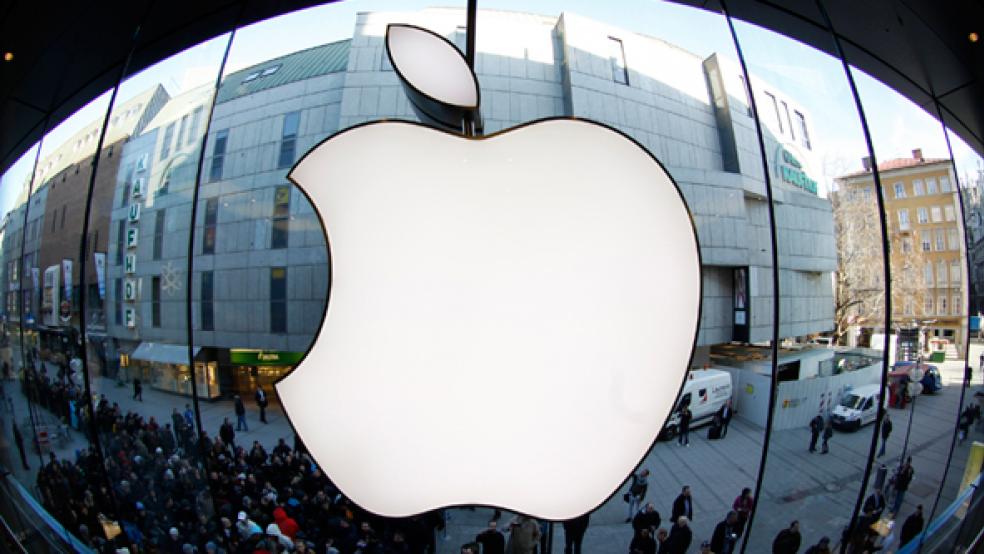Earlier this week we got confirmation of something we already knew: Apple has a killer brand. That was borne out by word that Coca-Cola’s 13-year winning streak atop the list of the world’s 100 most valuable brands – as computed by consultants at Interbrand, a division of Omnicom Group – had ended. The new leader is Apple, with fellow technology industry titan Google treading on its heels, pushing the venerable Coca-Cola brand all the way back into third place.
So does Apple’s share price fully reflect the value of that brand? Veteran investment manager Bill Miller of Legg Mason Capital Management (who knows something about the value of branding and about streaks), says he has viewed Apple as a consumer company with a great, high-end brand rather than a technology company for some time. As such, he argues, “they are deserving of a higher multiple.”
Perhaps he’s right. After all, it’s not every brand that can generate a mile-long queue along London’s Regent Street when it releases the latest product in a not-exactly-new category, as Apple did when its latest iPhones made their debut recently. (In Tokyo, the brand fanaticism was still more extreme, as Apple aficionados defied an oncoming typhoon and remained in line outdoors, waiting for the doors to open and Apple to begin selling the next-gen iPhones.)
RELATED: WHY WALL STREET HATES APPLE'S iPHONE 5C
In spite of all that enthusiasm – or downright mania – Apple still changes hands for less than $500 a share, well below its record high of nearly $700, and is trading at about 12 times trailing earnings. Nor has that stock price reacted much to the news of the company’s new honor. The rationale for that is – in part – the fact that Apple’s profit margins aren’t what they were at their peak in 2012. Admittedly, profit margins of 37 percent or so aren’t as enviable as the 47 percent that Apple boasted at its peak in the first quarter of 2012, but it’s still about the same level as in mid-2008, and higher than they were in the early part of the last decade.
Interbrand’s methodology factors in financial performance (as well as the ability of a brand to drive demand and consumer loyalty), so Apple’s profitability has helped lift it to the top of the list. Yet if you start contemplating Apple along those lines – as a consumer company with an iconic brand, valued at $98.3 billion by Interbrand – Miller is right: The current valuation doesn’t make sense.
For starters, let’s take a look at the runners-up in Interbrand’s survey. Google’s brand is valued at $93.3 billion and Coke’s at $79.2 billion. Coke trades at 19 times trailing earnings; Google at 26.5 times, in contrast to Apple’s meager price/earnings multiple.
Another interesting way to look at this is to compare the value of the brand to the company’s market capitalization. Coke’s brand value is roughly 48 percent of its market value; that of Google is 31.6 percent. At Apple, brand value represents only 22.1 percent of market capitalization. Even if you share the view of Carl Icahn and other activist investors that Apple has waaay too much cash on its books and that this is weighing on its valuation, that doesn’t explain away the discrepancy. Clearly, consumers place far more importance on Apple’s brand than investors are willing to offer.
The question of whether or not markets value brands correctly is particularly intriguing right now, and not just because of the Apple phenomenon. This week also brought news that rocked the fashion world: Designer Marc Jacobs is leaving Louis Vuitton after 16 years to launch his own brand and is planning a public offering for that brand. (Louis Vuitton ranked No. 17 on Interbrand’s survey; its estimated brand value of $24.89 billion is about 25 percent of the market capitalization of parent company LVMH Moet Hennessy Louis Vuitton, which includes an array of lesser-ranked brands.)
If companies have managed to make the overall brand more significant than any individual designer, so, too, the triumph of branding has made it possible for individual designers to transform themselves into popular brands in the same way that Coco Chanel did nearly a century ago.
That’s what another LVMH alumnus, Michael Kors, pulled off. Creating his own fashion firm, he built his brand and took the company public nearly two years ago in what remains one of the most successful recent IPOs. Michael Kors Holdings may not appear on the Interbrand rankings yet, but its 41.4 percent price gain in the last 12 months beats not only the S&P 500’s 16.3 percent advance but is more than double the gains of any of the top five brands in that Interbrand list. Kors’s fashion empire now trades at 32.9 times earnings – and the company announced in August that it was raising its earnings and revenue forecasts for the year, as a growing number of shoppers find the idea of being without a Michael Kors handbag as unimaginable as some find being without their iPhone.
Most great brands get to sell their products at a premium price, as those who have winced when comparing the cost of an iPhone to another smartphone or an iPad to a Kindle Fire will testify. What remains unclear is whether the market is equally willing to award a premium price to a brand. The data suggest that’s easier to do when the company in question is a venerable consumer brand or a fashion icon; more difficult when it’s a technology company. Certainly, if Apple’s experience is an example, we’re not yet at the point where we can talk about the value of a brand automatically reflected in the value of the company that owns it.





